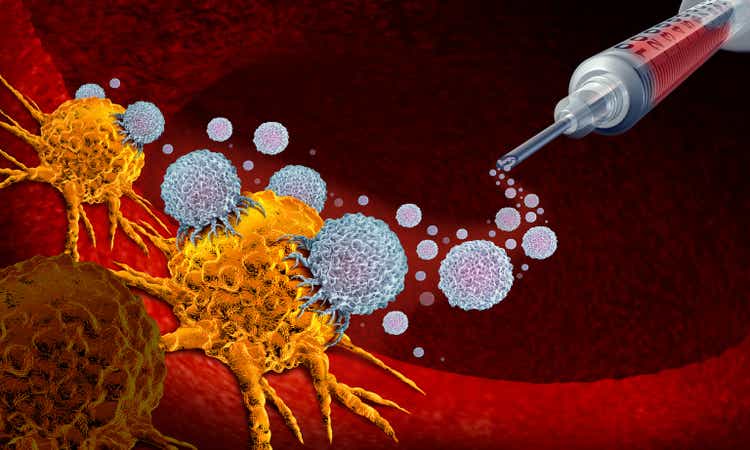wildpixel/iStock via Getty Images
Topline Summary and Update
Anixa Biosciences (NASDAQ:ANIX) is a biotech specializing in developing immunotherapy treatments for different types of cancer, most prominently breast and ovarian cancers. When I first covered them, I wrote about their very early-stage data and small current assets. As they continue to march forward, they remain in an incubatory period, with some price reject. More recently, the company reported results deemed negative by the market. Let’s converse.
Pipeline Updates
Vaccine technology
ANIX is continuing to progress a vaccine targeting α-lactalbumin, a protein that normally is only present for lactation but can become overexpressed in triple-negative breast cancer. They have presented some early data for this program, demonstrating some measure of safety and evidence of increased T-cell responses after treatment with the vaccine.
They are also pursuing development of a vaccine for ovarian cancer, exploiting the target AMHR2, an ovarian protein that should normally decrease as women go through menopause but that can be overexpressed in ovarian cancer. The most recent news for ANIX is that they’ve been granted patent protection in Europe for this technology.
At SABCS 2023, ANIX presented updated findings from their phase 1 research in patients with breast cancer. 16 patients were included in the analysis, with no significant side effects observed. The most important observation for the company was that biochemical signs of an immune response were observed, with elevations in specific cytokines hopefully portending that the immune system is being re-engaged against the tumor (in the case of this research, operable, high-risk, triple-negative breast cancer).
Now, ANIX is planning to add two more cohorts. One will combine the vaccine with pembrolizumab after surgery in patients who had residual disease following neoadjuvant chemotherapy. The other cohort will be women with BRCA1/2 or PALB1 mutations who do not yet have breast cancer but are considering a double mastectomy to hopefully hinder breast cancer in the future.
CAR T-cell therapy
ANIX is also involved in the development of a CAR T-cell therapy for ovarian cancer, and they recently announced that the first patient cohort has been completed in their phase 1 trial. This includes 3 patients, with no dose-limiting toxicities.
The company announced that they presented at the OCRA conference in a sponsored talk where they gave an overview of the phase 1 trial. We do not have access to this presentation, although it seems safe to say that no important data were incorporated into the talk, since that would have been something ANIX would be excited to share.
Financial Overview
As of their latest quarterly filing, ANIX held total current assets of $26.4 million, with $3.2 million in cash and equivalents and another $22.3 million in short-term investments. This is not a lot in terms of assets on hand, but their operating losses were also quite low at $2.8 million. After interest income, the net loss for ANIX was $2.5 million for the quarter.
This gives them a cash runway of approximately 9 quarters of cash on hand. Of course, that assumes that costs are kept under control, which would be an optimistic assessment. Trials don’t get cheaper as they mature!
Strengths and Risks
ANIX has in its hands now some signal that things are going according to scheme with their breast cancer vaccine. But make no mistake about it: this remains a very early stage company, taking things very cautiously. I’m not completely excited by these data, to be honest. A lot of biochemical readouts don’t pan out into effective cancer treatments. This notches things up from “I haven’t seen anything yet” to “maybe there’s something there.”
Meanwhile, their stewardship of funds has remained steady, a lot of time yet to mature in their clinical trial foundations. Still, ANIX presents potential new shareholders with a pretty long expect at this point.
Bottom-Line Summary
When I first covered ANIX, my impression was that there wasn’t much to go on before an important data readout. My sentiment at that time was “sell,” or at least a decisive “don’t buy.” However, now we have an early sign that the vaccine is doing what it’s supposed to, with the market valuing this news negatively. I speculate that this is because their phase 1 research did not yield “slam dunk” efficacy data, which is not a reasonable expectation in the first place.
As the company slips toward sub-$100 million market cap, the potential catalysts start to become more and more attractive. I certainly think it’s a mistake to view the recent SABCS data as “bad,” even if I’m not roaringly excited about it. So it’s difficult to preserve a negative sentiment until we learn more, and any piece of truly interesting good news could drive a lot of hype. Therefore, I’m upgrading my sentiment to a “hold” at this time. Neutral on selling, not ready to buy, but still something to watch as it develops.



